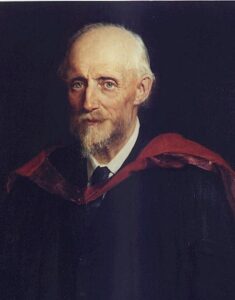Osborne Reynolds
Osborne Reynolds FRS was an Irish-born innovator in the understanding of fluid dynamics. Separately, his studies of heat transfer between solids and fluids brought improvements in boiler and condenser design. He spent his entire career at what is now the University of Manchester.
Osborne Reynolds, a British engineer, physicist, and educator best known for his work in hydraulics and hydrodynamics.
Reynolds was born into a family of Anglican clerics.Born in Belfast, Reynolds inherited a love of mathematics from his clergyman father, a headmaster with a mechanical bent who had patented several improved designs for agricultural equipment. Reynolds benefited from “the constant guidance of his father He gained early workshop experience by apprenticing with a mechanical engineer, and he graduated at Queens’ College, Cambridge, in mathematics in 1867. In 1868 he became the first professor of engineering at Owens College, Manchester, a position he held until his retirement in 1905. He became a fellow of the Royal Society in 1877 and received a Royal Medal in 1888.
Though his earliest professional research dealt with such properties as magnetism, electricity, and heavenly bodies, Reynolds soon began to concentrate on fluid mechanics. In this area he made a number of significant contributions. His studies of condensation and heat transfer between solids and fluids brought radical revision in boiler and condenser design, while his work on turbine pumps permitted their rapid development. He formulated the theory of lubrication (1886) and in 1889 developed the standard mathematical framework used in turbulence work.
The intricate motion of fluids is notoriously difficult to predict, due to these substances’ nonlinear nature. But physicists can predict whether the flow in a given system should be laminar or turbulent, thanks to an Irish-born physicist named Osborne Reynolds. Reynolds was a pioneer in the study of fluid dynamics, performing an elegant experiment to demonstrate that the critical transition point between the two types of flow could be predicted by one simple number. We now know it as the Reynolds number.
He also studied wave engineering and tidal motions in rivers and made pioneering contributions to the concept of group velocity. Among his other contributions were the explanation of the radiometer and an early absolute determination of the mechanical equivalent of heat. His paper on the law of resistance in parallel channels (1883) is a classic. The “Reynolds stress” in fluids with turbulent motion and the “Reynolds number” used for modeling in fluid flow experiments are named for him.

Osborne Reynolds
Date of Birth: 23 Aug 1842
Birth Place: Belfast, United Kingdom
Proffession: Designer
Nationality: Indian
Death: 21 February 1912, Watchet, United Kingdom


